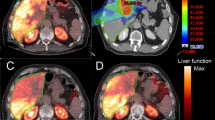Abstract
Purpose
To quantify the effects of absorbed radiation dose on healthy liver parenchyma following radioembolisation (RE) using [99mTc]TcMebrofenin to analyse both global and regional liver function.
Methods
Patients having RE to treat hepatic disease underwent a [99mTc]TcMebrofenin hepatobilliary scintigraphy (HBS) study at both baseline and 8 weeks following treatment. Changes in global liver uptake rate were compared with healthy liver absorbed dose measures derived from the post-treatment 90Y PET/CT, including average dose, minimum dose to 70% of the volume (D70) and volume receiving at least 50 Gy (V50). Changes in functional burden associated with treatment and spared liver volumes in patients receiving lobar RE were also assessed, as were changes experienced by regional volumes corresponding to various dose ranges. Standard liver function pathology tests (LFTs) (bilirubin, albumin, ALP, AST, ALT and GGT) were examined for changes between baseline and post-treatment.
Results
Thirty-five patients were included in the study, of which, 9 had lobar treatment. A significant linear correlation was found between both baseline global liver uptake rate (negative) and D70 with change in global liver uptake rate. Patients undergoing lobar treatments demonstrated a shift in functional burden, and a significant difference was seen between the mean dose corresponding to liver volumes that increased their functional burden (9 Gy) and those that decreased their functional burden (35 Gy). No baseline LFTs predicted a decrease in global liver function; however, D70 demonstrated a linear correlation with changes in bilirubin and GGT.
Conclusions
Given the significant negative relationship between baseline and change in global liver uptake rate, baseline HBS studies should not be used alone to disqualify patients considered for RE. In terms of treatment planning and evaluation, D70 may be the most appropriate metric of dose, with values greater than 15 Gy indicative of a likely drop in global liver function. The evidence of increasing functional burden in spared liver volumes suggests that patients at risk of complications could benefit from a lobar approach to treatment.








Similar content being viewed by others
References
Erdogan D, Heijnen BH, Bennink RJ, Kok M, Dinant S, Straatsburg IH, et al. Preoperative assessment of liver function: a comparison of 99m Tc-Mebrofenin scintigraphy with indocyanine green clearance test. Liver Int. 2004;24:117–23.
Gil-Alzugaray B, Chopitea A, Inarrairaegui M, Bilbao JI, Rodriguez-Fraile M, Rodriguez J, et al. Prognostic factors and prevention of radioembolization-induced liver disease. Hepatology. 2013;57:1078–87.
Chapelle T, Op de Beeck B, Driessen A, Roeyen G, Bracke B, Hartman V, et al. Estimation of the future remnant liver function is a better tool to predict post-hepatectomy liver failure than platelet-based liver scores. Eur J Surg Oncol. 2017;43:2277–2284.
Bennink RJ, Cieslak KP, van Delden OM, van Lienden KP, Klümpen H-J, Jansen PL, et al. Monitoring of total and regional liver function after SIRT. Frontiers in oncology. 2014;4:152-. doi:https://doi.org/10.3389/fonc.2014.00152.
Braat MNGJA, de Jong HW, Seinstra BA, Scholten MV, van den Bosch MAAJ, Lam MGEH. Hepatobiliary scintigraphy may improve radioembolization treatment planning in HCC patients. EJNMMI research. 2017;7:2-. doi:https://doi.org/10.1186/s13550-016-0248-x.
van der Velden S, Braat MNGJA, Labeur TA, Scholten MV, van Delden OM, Bennink RJ, et al. A pilot study on hepatobiliary scintigraphy to monitor regional liver function in yttrium-90 radioembolization. J Nucl Med. 2019. https://doi.org/10.2967/jnumed.118.224394.
Cremonesi M, Chiesa C, Strigari L, Ferrari M, Botta F, Guerriero F, et al. Radioembolization of hepatic lesions from a radiobiology and dosimetric perspective. Frontiers In Oncol. 2014;4.
Ekman M, Fjalling M, Friman S, Carlson S, Volkmann R. Liver uptake function measured by IODIDA clearance rate in liver transplant patients and healthy volunteers. Nucl Med Commun. 1996;17:235–42.
Tann M, Woolen S, Swallen A, Nelson A, Fletcher J. Establishing a normal reference range for mebrofenin clearance rate (MCR) for overall liver function assessment. J Nucl Med. 2015;56:A49.
Gulec SA, Sztejnberg ML, Siegel JA, Jevremovic T, Stabin M. Hepatic structural dosimetry in (90)Y microsphere treatment: a Monte Carlo modeling approach based on lobular microanatomy. J Nucl Med. 2010;51:301–10.
Chiesa C, Maccauro M, Romito R, Spreafico C, Pellizzari S, Negri A, et al. Need, feasibility and convenience of dosimetric treatment planning in liver selective internal radiation therapy with (90)Y microspheres: the experience of the National Tumor Institute of Milan. Q J Nucl Med Mol Imaging. 2011;55:168–97.
Author information
Authors and Affiliations
Corresponding author
Ethics declarations
Ethical considerations
All subjects included in this study gave written informed consent for their data to be used for research, education, training and audit purposes as part of their consent to treatment. All procedures performed in studies involving human participants were in accordance with the ethical standards of the 1964 Helsinki declaration and its later amendments or comparable ethical standards.
Conflict of interest
The authors declare that they have no conflict of interest.
Additional information
Publisher’s note
Springer Nature remains neutral with regard to jurisdictional claims in published maps and institutional affiliations.
This article is part of the Topical Collection on Dosimetry.
Rights and permissions
About this article
Cite this article
Willowson, K.P., Schembri, G.P., Bernard, E.J. et al. Quantifying the effects of absorbed dose from radioembolisation on healthy liver function with [99mTc]TcMebrofenin. Eur J Nucl Med Mol Imaging 47, 838–848 (2020). https://doi.org/10.1007/s00259-020-04686-1
Received:
Accepted:
Published:
Issue Date:
DOI: https://doi.org/10.1007/s00259-020-04686-1




